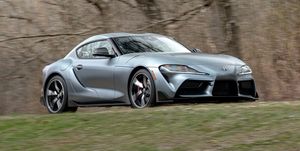We’d love to tell you how much the updated 2021 Toyota Supra costs with its base turbo inline-four. That’s the reason this new model exists: It will cost less than the turbo 3.0-liter inline-six version. Since the 2.0-liter four makes just 255 horsepower—a significantly lower number than the reinvigorated 3.0’s 382 horsepower—its price is central to the whole discussion. Is a four-banger Supra affordable enough to justify its paucity of ponies? Will it slide down into a new segment and draw an entirely different audience, the way the original Celica did? (Only when the Celica was granted six cylinders did it earn a Supra badge.) Well, we can’t tell you yet. Toyota plans to release pricing in mid-June, apparently to focus our minds on how the 2.0-liter Supra drives rather than how much it costs, as if the two aren’t inextricably intertwined.
Here’s what we do know: Even with a third fewer cylinders, the Supra is good fun. With 295 pound-feet of torque boiling up at 1550 rpm, the 2.0-liter engine feels brawny in its own way. It’s helped by a claimed 219-pound weight drop versus the six, a diet that stems from both the cylinder removal and a smattering of good old-fashioned de-contenting.
For instance, the four-cylinder model shares tire widths with the six—255s up front, 275s in back—but the four-cylinder car rolls on 18-inch wheels instead of 19s, which results in a little more sidewall for its Michelin Pilot Super Sport summer tires. The brake rotors are slightly smaller, and the front calipers are single-piston units versus the six’s four-piston clampers. Its seats adjust manually rather electrically. The standard sound system has four speakers instead of the six-cylinder’s 10 or 12, although the base car’s Safety and Technology Package, the only real option, adds a 12-speaker JBL stereo and assorted electronic driver-assistance systems. The 3.0’s electronically controlled limited-slip differential and adaptive dampers get 86’d for 2.0 duty. Speaking of which, the Supra’s claimed 3181-pound curb weight sounds trim until you consider that the Toyota 86 weighs around 2800 pounds and has back seats. Counterintuitively, the two-seat Supra is a significantly larger car, being roughly six inches longer and three inches wider than the 86.
Toyota claims a 5.0-second zero-to-60-mph time for the four-cylinder Supra, and our informal VBox polygraph test suggests that’s the truth. (Our testing grounds remain closed, but we promise a full test as soon as they reopen.) That’s certainly enough scoot to put a smile on your face, but the power deficit does change the way the Supra drives—not just in terms of straight-line speed but its handling as well. If you brake-torque the 2.0 off the line with its traction control disabled, it’ll momentarily scramble for traction and then hook right up, since there’s not enough thrust to totally overwhelm those wide rear Michelins. That consistent traction carries through in the corners.
The 2.0 would no doubt be a docile companion on a road course full of fast sweepers, but you’re not going to boot the tail out in slow corners for fun like you can with the 3.0. The standard eight-speed automatic transmission’s gearing is the same amongst all Supras, which is a little bit surprising. You’d think the four-cylinder would’ve at least gotten a shorter final-drive ratio to goose its launch, but Toyota’s quest for improved fuel economy probably scuttled that idea. That, and the need to maintain a wide enough margin from the 3.0’s sub-four-second zero-to-60-mph time.
When Toyota introduced the new Supra last year, it overtly declared that the car is built to be modified. The cooling system, for instance, is extra beefy because Toyota knows that tuners tend to throw additional boost at an engine before upgrading the ancillary systems. The four-cylinder seems, if anything, even more of a blank slate for upgrades. Prepare to see plenty of 18-inch Supra wheel-and-tire takeoffs on eBay in the years to come.
Given that the 2.0 is visually all but indistinguishable from its six-cylinder kin, it surely will make a more affordable case for the crowd that’s keen to start modding their cars five minutes after they get home from the dealer. There’s no aesthetic shame in the Supra’s four-cylinder game. And a typical “stage one” aftermarket treatment (new intake and exhaust and an engine-computer reflash) will likely bring the Bavarian four’s power output close to that of last year’s 335-hp six. Perhaps an uncorked intake will improve the indifferent four-cylinder soundtrack with some turbine whine and a little chuff of boost from the engine’s blow-off valve.
But even in stock form, the 2.0-liter Supra is a quick, fun rear-driver. Is it a good deal? That remains to be seen.
Source: Reviews - aranddriver.com









